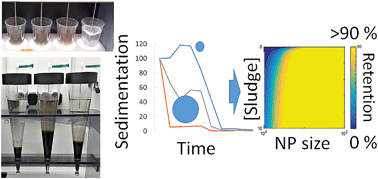当前位置:
X-MOL 学术
›
Environ. Sci.: Nano
›
论文详情
Our official English website, www.x-mol.net, welcomes your feedback! (Note: you will need to create a separate account there.)
Sludge concentration, shear rate and nanoparticle size determine silver nanoparticle removal during wastewater treatment
Environmental Science: Nano ( IF 7.3 ) Pub Date : 2017-10-04 00:00:00 , DOI: 10.1039/c7en00734e G. Cornelis 1, 2, 3, 4 , A. M. Forsberg-Grivogiannis 4, 5, 6, 7 , N. P. Sköld 4, 5, 6, 7 , S. Rauch 4, 7, 8, 9, 10 , J. Perez-Holmberg 4, 5, 6, 7
Environmental Science: Nano ( IF 7.3 ) Pub Date : 2017-10-04 00:00:00 , DOI: 10.1039/c7en00734e G. Cornelis 1, 2, 3, 4 , A. M. Forsberg-Grivogiannis 4, 5, 6, 7 , N. P. Sköld 4, 5, 6, 7 , S. Rauch 4, 7, 8, 9, 10 , J. Perez-Holmberg 4, 5, 6, 7
Affiliation

|
Wastewater treatment (WWT) is generally efficient in removing nanoparticles (NPs) from sewage effluent, but the variety in removal rates has not yet been explained. WWT parameters such as the activated sludge (AS) concentration, shear rate and ionic strength were varied in kinetic batch attachment and sedimentation studies using silver NPs having nominal 20 or 80 nm sizes and citrate or PEG coatings. The fitted attachment and detachment rate constants and the resulting distribution ratios at steady state varied with WWT process parameters, but most notably with the NP size, which was also found to influence the settling rates most. The NP coating molecules had a limited or no effect. A meta-analysis of literature distribution ratios (attached/detached concentration) of NPs composed of Ag and other materials showed the NP (aggregate) size as the only significant parameter. However, while the distribution ratio of silver NPs to AS increased linearly with AS concentration, the final effect of NP effluent concentrations is partly offset by decreased sedimentation rates. The results thus confirm that a WWT process is efficient in removing NPs from wastewater, but relatively small (<20 nm) non-aggregated NPs are somewhat more likely to exit a WWT process via the effluent into aquatic compartments compared to relatively larger NPs, which nearly entirely leave the WWT plants with the AS towards soils, incineration plants or landfills.
中文翻译:

污泥浓度,剪切速率和纳米颗粒大小决定了废水处理过程中银纳米颗粒的去除
废水处理(WWT)通常可以有效地从污水中去除纳米颗粒(NPs),但是去除率的变化尚未得到解释。WWT的参数(例如活性污泥(AS)浓度,剪切速率和离子强度)在动力学批次附着和沉降研究中使用具有标称20或80 nm尺寸的银NP以及柠檬酸盐或PEG涂层进行了变化。拟合的附着和分离速率常数以及在稳态下的最终分布比随WWT工艺参数而变化,但最显着的是NP尺寸,这也发现对沉降速率的影响最大。NP涂层分子的作用有限或无作用。对由Ag和其他材料组成的NP的文献分布比率(附着/脱离浓度)进行的荟萃分析显示,NP(集合体)的大小是唯一重要的参数。然而,尽管银纳米颗粒对AS的分布比率随AS浓度线性增加,但NP流出物浓度的最终影响部分被沉降速率降低所抵消。因此,结果证实了WWT工艺可有效去除废水中的NP,但相对较小(<20 nm)的非聚集NP更有可能退出WWT工艺与相对较大的NP相比,它们通过废水进入水室,而NP几乎完全将带有AS的WWT植物留给土壤,焚化厂或垃圾填埋场。
更新日期:2017-11-09
中文翻译:

污泥浓度,剪切速率和纳米颗粒大小决定了废水处理过程中银纳米颗粒的去除
废水处理(WWT)通常可以有效地从污水中去除纳米颗粒(NPs),但是去除率的变化尚未得到解释。WWT的参数(例如活性污泥(AS)浓度,剪切速率和离子强度)在动力学批次附着和沉降研究中使用具有标称20或80 nm尺寸的银NP以及柠檬酸盐或PEG涂层进行了变化。拟合的附着和分离速率常数以及在稳态下的最终分布比随WWT工艺参数而变化,但最显着的是NP尺寸,这也发现对沉降速率的影响最大。NP涂层分子的作用有限或无作用。对由Ag和其他材料组成的NP的文献分布比率(附着/脱离浓度)进行的荟萃分析显示,NP(集合体)的大小是唯一重要的参数。然而,尽管银纳米颗粒对AS的分布比率随AS浓度线性增加,但NP流出物浓度的最终影响部分被沉降速率降低所抵消。因此,结果证实了WWT工艺可有效去除废水中的NP,但相对较小(<20 nm)的非聚集NP更有可能退出WWT工艺与相对较大的NP相比,它们通过废水进入水室,而NP几乎完全将带有AS的WWT植物留给土壤,焚化厂或垃圾填埋场。


























 京公网安备 11010802027423号
京公网安备 11010802027423号